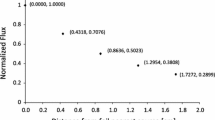Abstract
A variety of processes, from material sterilization and cancer treatment to used nuclear fuel recycling, benefit from quantifying the sensitivity of the system to radiation. Determining the effects of alpha irradiation on a system may be of complementary interest to the effects of gamma irradiation, as alpha radiation has higher linear energy transfer (LET) and will likely result in different chemical damage effects. This becomes important in advanced nuclear fuel cycle processes where the radioactive materials to be handled in solutions contain significant amounts of alpha emitters. Here we describe a method for studying high LET radiation in a liquid system using a TRIGA® reactor and the 10B(n,α)7Li reaction. By fitting a model based on neutron diffusion and absorption to experimentally obtained Fricke dosimetry data, the high LET dose to a sample was predictable over the full range of reactor power available and varying 10B concentration. This method may be applied to study the effects of high LET radiation on any liquid system as long as a suitable molecule containing boron is used and appropriate neutron diffusion coefficients are known. A wide range of high LET dose rates from <10 Gy/h to >1,000 kGy/h may be obtained with this method.






Similar content being viewed by others
References
Masuda T, Hatakeyama Y, Sunohara T (2005) Hollow fiber blood-processing device and method for packaging and sterilizing using a deoxidizer and radiation. U.S. Pat. Appl. Publ. US 20050063859 A1 20050324
Basly JP, Duroux JL, Bernard M (1996) Gamma irradiation sterilization of orciprenaline and fenoterol. Int J Pharm 142(1):125–128
Pascaud RS, Evans WT, McCullagh PJJ, FitzPatrick DP (1997) Influence of gamma-irradiation sterilization and temperature on the fracture toughness of ultra high-molecular-weight polyethylene. Biomaterials 18(10):727–735
Razavi B, Song W, Santoke H, Cooper WJ (2011) Treatment of statin compounds by advanced oxidation processes: kinetic considerations and destruction mechanisms. Radiat Phys Chem 80(3):453–461
Azar F, Yang HB, Venault L, Faure S (2012) Stability of water-soluble dyes under alpha and gamma radiation. Proceedings ATALANTE 2012—Nuclear Chemistry for sustainable fuel cycles, Montpolier, France, 2–7 Sep 2012
Holland JP, Merklin JF, Razvi J (1978) The radiolysis of dodecane-tributyl phosphate solutions. Nucl Instrum Methods 153:589–593
Mincher BJ, Modolo G, Mezyk SP (2009) Review article: the effects of radiation chemistry on solvent extraction: 1. Conditions in acidic solution and a review of TBP radiolysis. Solvent Extr Ion Exch 27:1–25
Fermvik A, Gruner B, Kvicalova M, Ekberg C (2011) Semi-quantitative and quantitative studies on the gamma radiolysis of C5-BTBP. Radiochim Acta 99:113–119
Choppin G, Liljenzin J, Rydberg J (2002) Radiochemistry and nuclear chemistry. Butterworth-Heinemann, Woburn
McDonell WR, Hart EJ (1954) Oxidation of aqueous ferrous sulfate solutions by charged particle radiations. J Am Chem Soc 76:2121–2124
Sugo Y, Taguchi M, Sasaki Y, Hirota K, Kimura T (2009) Radiolysis study of actinide complexing agent by irradiation with helium ion beam. Radiat Phys Chem 78:1140–1144
LaVerne JA, Enomoto K, Araos MS (2001) Heavy ion radiolysis of organic materials. Radiat Phys Chem 60:253–257
Ladrielle T, Wanet P, Lemaire D, Apers DJ (1983) Alpha and gamma induced radiolysis of tributyl phosphate. Radiochem Radioanal Lett 59:355–364
Lloyd MH,Fellows RL (1985) Alpha radiolysis and other factors affecting hydrolysis of tributyl phoshpate. In: Report ORNL TM-9565; Order No. DE85015071, Oak Ridge National Laboratory
Pearson J, Jan O, Miller GE, Nilsson M (2012) Studies of high linear energy transfer dosimetry by 10B(n, α)7Li reactions in aqueous and organic solvents. J Radioanal Nucl Chem 292:719–727
Schuler RH, Barr NF (1956) Oxidation of ferrous sulfate by ionizing radiations from (n,α) reactions of boron and lithium. J Am Chem Soc 78:5756–5762
Calabrese G, Nesnas JJ, Barbu E, Fatouros D, Tsibouklis J (2012) The formation of polyhedral boranes for the boron neutron capture therapy of cancer. Drug Discov Today 17:153–159
Hawthorne MR (1998) New horizons for therapy based on the boron neutron capture reaction. Mol Med Today 4:174–181
Kinashi Y, Masunaga S, Takagaki M, Ono K (1997) Mutagenic effects at HPRT locus induced in Chinese hamster ovary cells by thermal neutrons with or without boron compound. Mutat Res 377:211–215
Nakai H (1985) Increase in mutagenic efficiency of thermal neutrons through boron enrichment in rice seed. Environ Exp Bot 25:385–391
Saito M (1993) Relative biological effectiveness of the boron neutron-capture beam for the inactivation of biological macromolecules, from annual reports of the Research Reactor Institute. Kyoto Univ 26:59–68
Lamarsh JR (2002) Introduction to nuclear reactor theory. Addison-Wesley Pub. Co., Reading
Crofoot TA (1989) The determination of oxygen isotopic concentrations by neutron activation analysis and application to the determination of oxygen functional groups in coal by isotopic exchange. Ph.D. Thesis, Department of Chemistry, University of California Irvine
Hopewell JW, Morris GM, Schwint A, Coderre JA (2011) The radiobiological principles of boron neutron capture therapy: a critical review. Appl Radiat Isot 69:1756–1759
Olszanski A, Klassen NV, Ross CK, Shortt KR (2002) The IRS Fricke dosimetry system. Ionizing Radiation Standards Institute for National Measurement Standards National Research Council Ottawa, Ontario, K1A 0R6
Mezyk SP, Mincher BJ, Ekberg C, Skarnemark G (2012) Alpha and gamma radiolysis of nuclear solvent extraction ligands used for An(III) and Ln(III) separations. J Radioanal Nucl Chem 296:711–715
Acknowledgments
This project was funded by U.S. Department of Energy through the Nuclear Energy University Program (NEUP) project no. DE-AC07-05ID14517.
Author information
Authors and Affiliations
Corresponding author
Rights and permissions
About this article
Cite this article
Pearson, J., Jan, O., Wariner, A. et al. Development of a method for high LET irradiation of liquid systems. J Radioanal Nucl Chem 298, 1401–1409 (2013). https://doi.org/10.1007/s10967-013-2549-0
Received:
Published:
Issue Date:
DOI: https://doi.org/10.1007/s10967-013-2549-0




